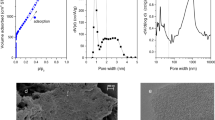Abstract
The storage of large quantities of hydrogen at safe pressures1 is a key factor in establishing a hydrogen-based economy. Previous strategies—where hydrogen has been bound chemically2, adsorbed in materials with permanent void space3 or stored in hybrid materials that combine these elements3—have problems arising from either technical considerations or materials cost2,3,4,5. A recently reported6,7,8 clathrate hydrate of hydrogen exhibiting two different-sized cages does seem to meet the necessary storage requirements; however, the extreme pressures (∼ 2 kbar) required to produce the material make it impractical. The synthesis pressure can be decreased by filling the larger cavity with tetrahydrofuran (THF) to stabilize the material9, but the potential storage capacity of the material is compromised with this approach. Here we report that hydrogen storage capacities in THF-containing binary-clathrate hydrates can be increased to ∼4 wt% at modest pressures by tuning their composition to allow the hydrogen guests to enter both the larger and the smaller cages, while retaining low-pressure stability. The tuning mechanism is quite general and convenient, using water-soluble hydrate promoters and various small gaseous guests.




Similar content being viewed by others
References
Berry, G. D. & Aceves, S. M. Onboard storage alternatives for hydrogen vehicles. Energy Fuels 12, 49–55 (1998)
Schlapbach, L. & Zuttel, A. Hydrogen-storage materials for mobile applications. Nature 414, 353–358 (2001)
Weitkamp, J., Fritz, M. & Ernst, S. Zeolites as media for hydrogen storage. Int. J. Hydrogen Energy 20, 967–970 (1995)
Schimmel, H. G. et al. Hydrogen adsorption in carbon nanostructures: Comparison of nanotubes, fibers, and coals. Chem. Eur. J. 9, 4764–4770 (2003)
Rosi, N. L. et al. Hydrogen storage in microporous metal-organic frameworks. Science 300, 1127–1129 (2003)
Mao, W. L. et al. Hydrogen clusters in clathrate hydrate. Science 297, 2247–2249 (2002)
Patchkovskii, S. & Tse, J. S. Thermodynamic stability of hydrogen clathrates. Proc. Natl Acad. Sci. USA 100, 14645–14650 (2003)
Mao, W. L. & Mao, H. Hydrogen storage in molecular compounds. Proc. Natl Acad. Sci. USA 101, 708–710 (2004)
Florusse, L. J. et al. Stable low-pressure hydrogen clusters stored in a binary clathrate hydrate. Science 306, 469–471 (2004)
Jeffrey, G. A. in Comprehensive Supramolecular Chemistry Vol. 6 (eds MacNicol, D. D, Toda, F. & Bishop, R.) 757–788 (Pergamon, Oxford, 1996)
Nakamoto, K. Infrared and Raman Spectra of Inorganic and Coordination Compounds 4th edn (Wiley, New York, 1986)
Nakahara, J. et al. C. C. Raman spectra of natural clathrates in deep ice cores. Phil. Mag. B 3, 421–430 (1988)
Lokshin, K. A. et al. Structure and dynamics of hydrogen molecules in the novel clathrate hydrate by high pressure neutron diffraction. Phys. Rev. Lett. 93, 125503 (2004)
Acknowledgements
This work was supported by the Korea Research Foundation and the Brain Korea 21 Project.
Author information
Authors and Affiliations
Corresponding authors
Ethics declarations
Competing interests
The authors declare that they have no competing financial interests.
Supplementary information
Supplementary Methods
Describes the additional information on the experimental methods of XRD and Raman spectroscopy to obtain the structural information and identify the molecular behaviour of H2 in hydrate cages. (DOC 28 kb)
Supplementary Figures S1-S3
Contains three Supplementary Figures. Figure S1 shows the powder XRD pattern for the double hydrate. Supplementary Figure S2 shows the phase behaviour of the double hydrate for 5.56 mol% THF concentration. As it can be seen in Supplementary Figure S3, the effect of the extinction coefficient in this study can be treated as a constant value regardless of THF concentrations. (DOC 122 kb)
Supplementary Table S1
This table shows the powder XRD patterns of THF + H2 double hydrate. Indexed results show that the formed structure of THF + H2 double hydrate is sII hydrate. (DOC 33 kb)
Rights and permissions
About this article
Cite this article
Lee, H., Lee, Jw., Kim, D. et al. Tuning clathrate hydrates for hydrogen storage. Nature 434, 743–746 (2005). https://doi.org/10.1038/nature03457
Received:
Accepted:
Issue Date:
DOI: https://doi.org/10.1038/nature03457
- Springer Nature Limited
This article is cited by
-
Probing the critical nucleus size in tetrahydrofuran clathrate hydrate formation using surface-anchored nanoparticles
Nature Communications (2024)
-
Hydrogen technologies and policies for sustainable future: a review
Chemical Papers (2024)
-
Gas Hydrates for Hydrogen Storage: A Comprehensive Review and Future Prospects
Korean Journal of Chemical Engineering (2024)
-
Significance of the high-pressure properties and structural evolution of gas hydrates for inferring the interior of icy bodies
Progress in Earth and Planetary Science (2023)
-
Rapid and efficient hydrogen clathrate hydrate formation in confined nanospace
Nature Communications (2022)





